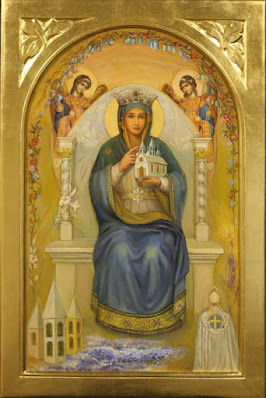Isaiah 40:4-5.
Michael Sternbeck
The Saint Bede Studio
December 2021
 |
| Mother of the Church |
Something quite different, however, is a focussed contempt for our heritage, as opposed to a mere lack of interest. What we have observed coming from the Vatican over the last several months is most certainly the former : contempt.
I wish to make a few points in this article, not demanding too much time of readers, since our focus should be on more beautiful moments in this Holy Season.
Within the Church, we do not perceive our heritage in quite the same way as secular society, instead of heritage we use the word Tradition from that definition of the Latin word which means a handing down or a handing on. Our Catholic Tradition concerns the teachings of the Church, but it also applies to certain externals, such as our ritual worship.
The Church at present seems to be in the grip of an imperative for cultural revision, not unrelated to similar movements in the twentieth century in Russia, China and Germany (to name a few). Part of the program of those atheistic regimes was the elimination and re-configuring of "heritage" into ideologies to which all persons must be subservient. It sounds familiar, doesn't it?
After those 20th century tragedies, brought about by aggressive, godless ideologies and the obsessions of hate-filled dictators, and which caused the suffering of millions, who could believe that our Holy Mother the Church would find herself in the twenty-first century in the thrall of another populist leader bent on reconfiguring Her in his own image? And yet ...
Every Catholic, no matter of what ecclesiological persuasion, age or race, ought to be concerned that the leaders of the Church are attempting to negate our Tradition and cast it as something to be sneered at and loathed. For this is the message coming from the Vatican with none-too-much subtlety.
The old liturgies of the Roman Rite are not to everyone's taste; they don't encapsulate a form of perfection which can admit of no modification or improvement. The Fathers of the Second Vatican Council recognised that, and sought to make some changes in the famous document Sacrosanctum Concilium. But now this same document is used as a weapon by the Vatican in a manner never dreamed of by the Fathers of the Second Vatican Council; whilst at the same time they attempt to convince the Faithful with their smooth words that restriction is exactly what the Fathers of the Council would really want for the sake of unity.
It must be admitted that there are some adherents of the Old Roman Rite who also have extreme views both political and ecclesiastical. BUT the opponents of the Old Liturgy in Rome - without a great deal of discernment and an outright lack of charity - have used the extreme views of such a minority to persecute those who just wish to attend the form of Mass of their choice. For those people, their religious heritage and personal sanctification are important.
There is something almost schizophrenic in these Roman regulations. They are patently vindictive, undiscerning, lacking in charity (from churchmen?). And they are most certainly motivated by ideology. Ideology ... yes ... we remember what happened in the past when ideology prevailed.
Let us recognise these deformed acts for what they are and not be fooled that they are based in a charitable desire for unity.
Under God's Providence, may these aberrations be brought to a swift close and a new leader for our Holy Mother emerge whose declared determination is not "to make a mess", but rather to bind up the wounds of Christ's Faithful, a flock scattered by its shepherd.
Mary, Mother of the Church, pray for us.
Michael Sternbeck
22nd December 2021.
This very popular range of vestments we call Ave Maris Stella. The vestments are made from an ecclesiastical brocade in the shade of ivory and lined in Royal blue taffeta. The ornament is formed from one of the Saint Bede Studio's unique braids, named Stella.
Click on the images for an enlarged view.
Enquiries : This page
 Recently, the Saint Bede Studio provided this simple set of violet vestments to a Benedictine Monastery in the United States. It is part of our economy range of vestments, called Saint Anselm.
Recently, the Saint Bede Studio provided this simple set of violet vestments to a Benedictine Monastery in the United States. It is part of our economy range of vestments, called Saint Anselm.